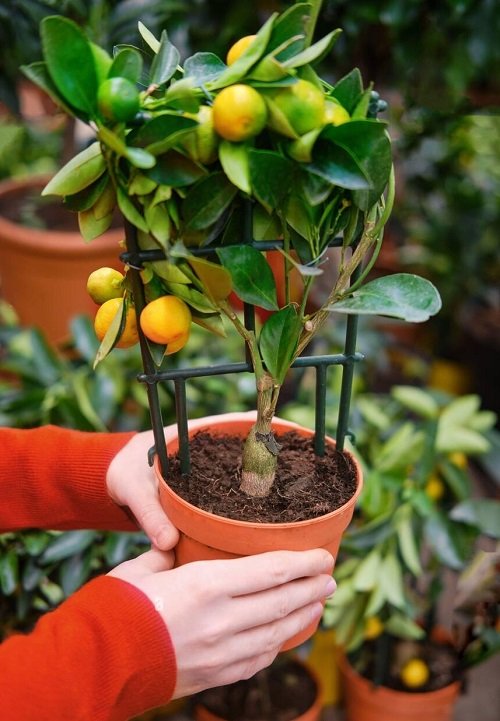Do you love oranges? Do you want to grow your own sweet orange tree and enjoy its delicious fruits, fragrant flowers, and glossy leaves? If you answered yes, then you are not alone.
Oranges are one of the most popular and widely cultivated fruits in the world. They are rich in vitamin C, antioxidants, and fiber, and have many health benefits. But oranges are not only good for eating, they are also beautiful and rewarding plants to grow in your garden or a pot.
In this article, we will show you how to plant, how to grow, and how to care for a sweet orange tree.
Read on!

Table of contents
- What is a Sweet Orange Tree?
- Where Did the Sweet Orange Tree Originate from?
- How to Plant a Sweet Orange Tree?
- How to Care for a Sweet Orange Tree in Winter?
- How Long Does it Take for a Sweet Orange Tree to Bear Fruit?
- How to Protect Sweet Orange Tree from Pests and Diseases?
- What Harvesting Tips Should I Follow for Sweet Oranges?
- Uses of a Sweet Orange Tree?
- FAQs
- Conclusion
- References
- Recommendations
What is a Sweet Orange Tree?
A sweet orange tree (Citrus sinensis) is a hybrid between a pomelo (Citrus maxima) and a mandarin (Citrus reticulata). It belongs to the Rutaceae family, which includes other citrus fruits such as lemons, limes, and grapefruits.
Additionally, it is an evergreen tree that can reach up to 30 feet in height and width, with a rounded crown of leathery, shiny, green leaves. It produces white, five-petaled, highly fragrant flowers that attract bees and other pollinators, and round, orange-colored fruits that have a sweet and juicy pulp divided into segments.
The fruits can vary in size, shape, color, and flavor, depending on the variety and the growing conditions. Some of the most common varieties of sweet oranges are Valencia, Washington, Navel, and Blood oranges.
See also: Ferns: Are they Perennial Plant? All you need to know
Where Did the Sweet Orange Tree Originate from?
The sweet orange tree is not a wild fruit, but a result of human domestication and selection. It originated in a region that encompasses southern China, northeast India, and Myanmar, and the earliest mention of it was in Chinese literature in 314 BC.
The sweet orange tree was introduced to Europe by Portuguese explorers in the 15th century, and then to the Americas by Spanish colonists in the 16th century.
Today, the sweet orange tree is grown in tropical and subtropical regions around the world, with Brazil, China, and India being the top producers.
See also: How Far Apart to Plant Tomatoes: Gardening Spacing Technique
How to Plant a Sweet Orange Tree?
There are two ways to plant a sweet orange tree: from seeds or grafted plants.
Planting from seeds is cheaper and more fun, but it has some disadvantages. First, it takes longer for the seedlings to grow and bear fruit, usually 4 to 6 years. Second, the seedlings may not be true to the parent plant, meaning that they may have different characteristics and qualities. Third, the seedlings may be more susceptible to diseases and pests, especially the citrus greening disease, which is a bacterial infection that causes the yellowing and dropping of leaves, and deformed and bitter fruits.

Planting from grafted plants is more expensive and less adventurous, but it has some advantages. First, it takes less time for the plants to grow and bear fruit, usually 2 to 3 years. Second, the plants are true to the parent plant, meaning that they have the same characteristics and quality. Third, the plants are more resistant to diseases and pests, especially if they are grafted onto a dwarfing rootstock, which reduces the size and vigor of the plant.

Steps
Whether you choose to plant from seeds or grafted plants, here are some steps to follow:
- Choose a sunny and well-drained spot for your sweet orange tree. It needs at least 6 to 8 hours of direct sunlight per day and a soil that is rich, loamy, and slightly acidic (pH 6 to 7). Avoid planting near buildings, power lines, or other trees that may shade or compete with your sweet orange tree.
- Dig a hole that is twice as wide and as deep as the root ball of your plant. If you are planting seeds, sow them about 1/2 inch deep and 6 inches apart. If you are planting from grafted plants, remove the container and gently loosen the roots. Place the plant in the center of the hole, making sure that the graft union (the point where the scion and the rootstock are joined) is above the soil level. Fill the hole with soil and water well.
- Apply a layer of mulch around the base of your sweet orange tree, leaving a few inches of space around the trunk. Mulch helps to retain moisture, prevent weeds, and moderate soil temperature. You can use organic materials such as wood chips, straw, or grass clippings, or synthetic materials such as plastic or fabric.
- Stake your sweet orange tree if it is young, weak, or exposed to strong winds. Use a sturdy stake that is taller than the plant, and tie it loosely with a soft material such as cloth or twine. Do not use wire or metal, as they may damage the bark and the cambium of the plant.
See also: How to Dry Roses Quickly | Best Expert Guide
How to Care for a Sweet Orange Tree in Winter?
You can care for a sweet orange tree in winter by protecting it from frost, reducing watering and fertilizing, and monitoring for pests and diseases. Here are some tips to follow:
- Protect your sweet orange tree from frost, by moving it indoors if it is in a pot, or by covering it with a frost cloth, a blanket, or a plastic sheet if it is in the ground. You can also wrap the trunk and the branches with burlap, straw, or newspaper, and mulch the base of the plant with leaves, straw, or wood chips. Do not use metal or glass, as they may conduct cold and damage the plant. Remove the coverings when the temperature rises above freezing, and allow the plant to breathe and receive sunlight.
- Reduce watering and fertilizing your sweet orange tree in winter, as it is dormant and does not need much water or nutrients. Water only when the soil feels dry, and fertilize only once in mid-winter, using a low-nitrogen fertilizer. Too much water or nitrogen can cause root rot, leaf burn, and fruit drop.
- Monitor your sweet orange tree for pests and diseases in winter, as it may be more susceptible to them due to the stress of cold and dryness. Look for signs of fungal diseases, such as anthracnose, scab, and greasy spots, which cause dark spots, scabs, and oily patches on the leaves and fruits. Treat the plant with a fungicide, following the instructions on the label. Look for signs of pests, such as aphids, whiteflies, and thrips, which suck the sap and cause yellowing, curling, and distortion of the leaves and fruits.
See also: How to Get Rid of Ground Hornets
How Long Does it Take for a Sweet Orange Tree to Bear Fruit?
The anticipation of a bountiful harvest from your sweet orange tree is part of the joy of cultivating this citrus delight. However, patience is key, as it typically takes 3 to 4 years for a newly planted sweet orange tree to bear fruit. During this initial period, the tree focuses on establishing its root system and developing the necessary structure for future fruit production.
To expedite the fruit-bearing process, consistent care and maintenance are essential. Ensure your sweet orange tree receives adequate sunlight, which is crucial for stimulating flower development and, subsequently, fruit formation. Regular pruning to maintain shape and remove dead or crowded branches promotes optimal growth conditions.
While the wait for that first harvest may seem long, the rewards of homegrown sweet oranges are well worth it. Dedication to the care of your tree during its early years sets the stage for a fruitful outcome, ensuring a steady supply of delicious citrus fruits for years to come. Embrace the journey, knowing that the sweet taste of success is just around the corner.
See also: How to Propagate Aloe: Plant Cultivation Method
How to Protect Sweet Orange Tree from Pests and Diseases?
Shielding your sweet orange tree from the threats of pests and diseases is crucial for ensuring a healthy and productive citrus grove. Regular inspection is the first line of defense. Keep a vigilant eye on your tree, checking for common pests such as aphids and scale insects. Swift action is essential if any infestations are detected.
For organic pest control, consider using neem oil or insecticidal soap. These natural remedies effectively combat pests without harming the environment or beneficial insects. Apply these solutions as directed, paying particular attention to the undersides of leaves where pests often reside.
In addition to pests, sweet orange trees can be susceptible to diseases like citrus canker. Preventive measures involve applying a copper fungicide, creating a protective barrier against potential infections. Regularly prune your tree to remove dead or diseased branches, reducing the risk of disease spread.
Maintaining a clean and tidy garden environment also contributes to pest and disease prevention. Remove fallen leaves and debris around the sweet orange tree, as these can harbor pests and fungal pathogens. By adopting these proactive measures, you create a resilient shield around your sweet orange tree, ensuring a thriving and disease-free citrus haven.
See also: How to Propagate Monstera: Green Thumb Techniques for Lush Plant Growth
What Harvesting Tips Should I Follow for Sweet Oranges?
Harvesting sweet oranges is the pinnacle of a journey that begins with the careful cultivation of a thriving citrus tree. This final stage, when executed with precision, ensures not only the best quality fruit but also the continued health and productivity of your sweet orange tree. Let’s delve into key harvesting tips that will elevate your citrus harvesting experience.
To start, recognizing the optimal moment for harvesting is paramount. Sweet oranges should be picked when they attain their mature color and size, signaling peak ripeness. This patience in waiting for full maturity enhances the sweetness and flavor profile of the fruit.
Equally crucial is the gentle handling of the harvest. The use of pruning shears is recommended, facilitating a clean cut while leaving a short stem attached. This careful approach minimizes the risk of bruising or damage, contributing to the overall longevity of the fruit and reducing the chances of introducing pathogens.
Timing plays a vital role in the harvesting process. Choosing the right time of day, preferably in the morning when temperatures are cooler, is a strategic move. This not only preserves the freshness and flavor of the oranges but also minimizes stress on the tree.
Regular checks during the harvesting season are imperative. Harvesting ripe fruits promptly prevents overloading branches, a practice that can lead to stress on the tree and potentially impact future yields.
See also: IFT Seeding The Future Global Food System Challenge
Uses of a Sweet Orange Tree?
You can use a sweet orange tree for many purposes, such as eating, juicing, cooking, baking, preserving, and decorating. Here are some ideas to try:
- Eat the fruits fresh, by peeling them and eating them as they are, or by slicing them and adding them to salads, fruit bowls, or yogurt. You can also dip the slices in chocolate, honey, or sugar, for a sweet treat.
- Juice the fruits, by squeezing them by hand or by using a juicer, and drinking the juice as it is, or by adding it to smoothies, cocktails, or lemonade. You can also freeze the juice in ice cube trays, and use it later for cooking or baking.
- Cook the fruits, by boiling them in water or syrup, and adding them to soups, stews, sauces, or jams. You can also roast them in the oven, and serve them with meat, poultry, or fish.
- Bake the fruits, by grating the peel and adding it to cakes, muffins, cookies, or pies. You can also puree the flesh and add it to bread, pancakes, or waffles.
See also: Lewisia: All you need to know about the Garden Flower
FAQs
It can take three to five years for an orange tree to produce fruit, depending on how old the tree is when purchased. Once the tree finally begins producing fruit, it takes 7 to 8 months to ripen.
Orange trees thrive in subtropical regions with warm temperatures and moderate humidity levels. They can be grown outdoors in USDA hardiness zones 9 to 11 and begin to go dormant when temperatures dip below 50 degrees Fahrenheit.
Conclusion
The journey of cultivating a sweet orange tree is a delightful adventure that rewards patience and care with the sweet fruits of your labor.
By selecting the right variety, providing optimal growing conditions, and maintaining a consistent care routine, you can enjoy the vibrant colors and flavors of homegrown sweet oranges.
So, roll up your sleeves, get your hands dirty, and embark on a citrus-filled journey to transform your garden into a sweet orange haven.
References
- Wikipedia.org – Citrus × sinensis
- Thespruce.com – How to Grow and Care for Orange Trees
- Housedigest.com – How To Grow and Care For an Orange Tree





